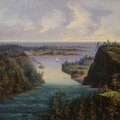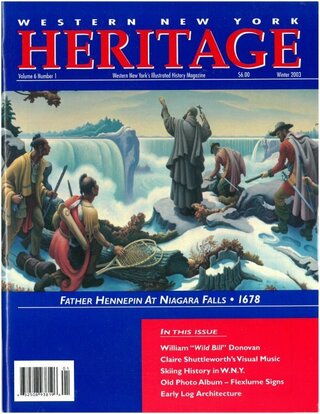The large mural painted by Thomas Hart Benton for the New York State Power Authority was commissioned by Robert Moses in 1958. The work was completed and installed in 1961 in “Power Vista,” the Visitor Center of the great Niagara hydroelectric project. Benton spent a year and a half researching the subject and six months painting the mural.
At the time of this commission, Thomas Hart Benton (1889-1975) was considered the most important mural artist in America. Throughout his long career Benton was a controversial, flamboyant and outspoken, anti-establishment socialist. Born in Missouri in 1889, he was named to honor his great uncle, Senator Thomas Hart Benton. As a young man Benton studied in Chicago, Paris and New York. His early work was decidedly abstract. In New York City he was a major influence on Jackson Pollack.
Benton became a leading figure in “The American Scene Movement” celebrating American history, regionalism and pop culture. In the early 1920s the artist produced a series of murals entitled “The American Historical Epic” for the New School of Social Research in New York City. The popularity of these murals is considered to have been a key element in gaining support for the important Federal Art Projects of the depression years.
Benton’s best work contains a dynamic combination of abstraction and realism. From 1935 until his death in 1975 Thomas Hart Benton kept his studio in Kansas City, Missouri. Fellow outspoken Missourian, President Harry Truman termed Benton "the best damned painter in America.”
In 1999 the Hennepin mural was loaned for display at the New York State Museum. Mark Schaming, the Director of Exhibitions, said, “this piece is truly one of Thomas Hart Benton’s masterpieces, telling a great New York story in the epic manner he is known for.”
The epic story the mural tells is that of the Franciscan priest Father Louis Hennepin, confronting the awesome spectacle and power of the great natural wonder of the world, Niagara Falls. He was chaplain with an advance party of the famous La Salle exploration expedition. Although Father Hennepin may not have been the first European to view the Falls, he was the first to describe it and make it known to the world.
The Belgian-born Hennepin had entered the Franciscan order at age seventeen “to live in the rule of pure strict virtue.” As a priest he had traveled extensively in Italy, France and Germany visiting Franciscan churches. In 1674 he attended to the wounded on the bloody battlefield of Seneff. He had been fascinated by tales of adventure told by sailors and sea captains who voyaged to the new world. “I often hid behind the tavern doors, while the sailors were talking…the tobacco smoke sickened me terribly, yet I listened eagerly to all that these men told of their adventures.”
He came to New France in 1675 as a Franciscan missionary, crossing on the same ship that carried Francois Laval, the new Bishop of Quebec, and Robert Cavelier Sieur de La Salle. La Salle had a commission to operate Fort Frontenac at the eastern end of Lake Ontario. Hennepin would be stationed at a little mission nearby.
On November 18, 1678, Hennepin and sixteen men left Fort Frontenac in a ten-ton brigantine as the advance party to Niagara under the command of the Sieur de la Motte. On the 6th of December 1678, “we entered the beautiful river Niagara which no barque had ever yet entered.”
Ascending the river by canoe to the escarpment they first explored the western side all the way to Chippewa Creek in foot-deep snow, finding no suitable place for the shipyard. “We passed back by the great Fall of Niagara and employed ourselves during half a day contemplating this prodigious cascade." Surprised to see such a great falls in a land almost completely flat, Hennepin notes that it is the outpouring of the continent’s interior and part of the St. Lawrence River system. His account of the view depicted in the Benton mural is as follows: “The two great sheets of water, that are on two sides of the sloping island that is in the middle, glide over without noise but at the bottom they roar greater than thunder.” He said, “there is no parallel in the universe.”
Father Hennepin was fifty-two years old in 1678. He had a strong physical constitution, since in January of 1679 he traveled on foot to the Seneca village at Tegarondies (Victor, NY) and walked back to Niagara through the cold and snow.
He served as chaplain to the crew during the building of the Griffon at Cayuga Creek and described the launching and the maiden voyage of that first sailing vessel on the upper lakes. Hennepin himself was embarked on a great adventure in which he would almost completely circumscribe all the Great Lakes, exploring the upper Mississippi to the Lake of the Woods and returning through Niagara in the fall of 1681. In 1682 he made the voyage back to France. His “A Description of Louisiana: A New Discovery Southwest of New France” was ready publication by September of 1682. Printed in January of 1683, it was soon translated into Italian, Dutch, German and English. A more detailed description of Niagara Falls accompanied by Hennepin’s own sketch of the falls was published in 1697 under the title “A New Discovery of a Vast Land.” Hennepin never returned to the new world finishing his life as a parish priest, dying in Utrecht, the Netherlands, in 1705 at 80 years of age.










